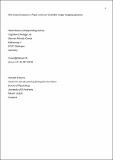Files in this item
Wild chacma baboons (Papio ursinus) remember single foraging episodes
Item metadata
| dc.contributor.author | Noser, R. | |
| dc.contributor.author | Byrne, R.W. | |
| dc.date.accessioned | 2016-04-01T23:01:19Z | |
| dc.date.available | 2016-04-01T23:01:19Z | |
| dc.date.issued | 2015-07 | |
| dc.identifier.citation | Noser , R & Byrne , R W 2015 , ' Wild chacma baboons ( Papio ursinus ) remember single foraging episodes ' , Animal Cognition , vol. 18 , no. 4 , pp. 921-929 . https://doi.org/10.1007/s10071-015-0862-4 | en |
| dc.identifier.issn | 1435-9448 | |
| dc.identifier.other | PURE: 181536316 | |
| dc.identifier.other | PURE UUID: 9df33b4f-0a55-4066-812d-cafbaf70dbe2 | |
| dc.identifier.other | Scopus: 84930541740 | |
| dc.identifier.other | ORCID: /0000-0001-9862-9373/work/60630597 | |
| dc.identifier.other | WOS: 000355923300012 | |
| dc.identifier.uri | https://hdl.handle.net/10023/8547 | |
| dc.description | This study was supported by grants from Zürcher Hochschulverein, Schweizerische Akademie für Naturwissenschaften, Stiftung Thyll-Dürr, and Stiftung Annemarie Schindler, to R.N. | en |
| dc.description.abstract | Understanding animal episodic-like memory is important for tracing the evolution of the human mind. However, our knowledge about the existence and nature of episodic-like memory in non-human primates is minimal. We observed the behaviour of a wild male chacma baboon faced with a trade-off between protecting his stationary group from aggressive extra-group males and foraging among five out-of-sight platforms. These contained high-priority food at a time of natural food shortage. In 10 morning and eight evening trials, the male spontaneously visited the platforms in five and four different sequences, respectively. In addition, he interrupted foraging sequences at virtually any point on eight occasions, returning to the group for up to 2 h. He then visited some or all of the remaining platforms and prevented revisits to already depleted ones, apparently based on his memory for the previous foraging episode about food value, location, and time. Efficient use of memory allowed him to keep minimal time absent from his group while keeping food intake high. These findings support the idea that episodic-like memory offers an all-purpose solution to a wide variety of problems that require flexible, quick, yet precise decisions in situations arising from competition for food and mates in wild primates. | |
| dc.format.extent | 9 | |
| dc.language.iso | eng | |
| dc.relation.ispartof | Animal Cognition | en |
| dc.rights | Copyright Springer-Verlag Berlin Heidelberg 2015. The final publication is available at Springer via http://dx.doi.org/10.1007/s10071-015-0862-4 | en |
| dc.subject | Foraging | en |
| dc.subject | Episodic-like memory | en |
| dc.subject | Baboons | en |
| dc.subject | Feeding platforms | en |
| dc.subject | Flexibility | en |
| dc.subject | BF Psychology | en |
| dc.subject | QL Zoology | en |
| dc.subject | NDAS | en |
| dc.subject.lcc | BF | en |
| dc.subject.lcc | QL | en |
| dc.title | Wild chacma baboons (Papio ursinus) remember single foraging episodes | en |
| dc.type | Journal article | en |
| dc.description.version | Postprint | en |
| dc.contributor.institution | University of St Andrews. School of Psychology and Neuroscience | en |
| dc.identifier.doi | https://doi.org/10.1007/s10071-015-0862-4 | |
| dc.description.status | Peer reviewed | en |
| dc.date.embargoedUntil | 2016-04-02 |
This item appears in the following Collection(s)
Items in the St Andrews Research Repository are protected by copyright, with all rights reserved, unless otherwise indicated.

